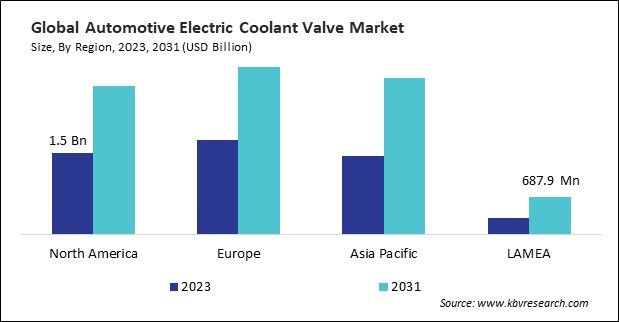According to a new report, published by KBV research, The Global Automotive Electric Coolant Valve Market size is expected to reach $9.3 billion by 2031, rising at a market growth of 8.3% CAGR during the forecast period. In the year 2023, the market attained a volume of 62,618.8 thousand units, experiencing a growth of 20.1% (2020-2023).
The 24 V segment is exhibiting a CAGR of 9.6% during (2024 - 2031). 24V systems offer higher voltage and power capabilities, enabling electric coolant valves to operate more efficiently and effectively, especially in larger vehicles or those with higher cooling requirements. This enhances the thermal management system's functionality and dependability, improving the overall longevity and performance of the vehicle. A growing need for compatible components supporting increasingly technologically advanced vehicle systems, including advanced driver assistance systems (ADAS), electrified drivetrains, and connectivity solutions.

The Two Way segment is generating the highest revenue for the Global Automotive Electric Coolant Valve Market by Type in 2023; thereby, achieving a market value of $4 billion by 2031. Two-way electric coolant valves are compatible with standard engine cooling systems in various vehicles, including passenger cars, trucks, and SUVs. They can easily replace traditional mechanical valves or thermostats, offering an upgrade path for automakers seeking to enhance cooling system performance and efficiency.
The Field-configurable segment is registering a CAGR of 9.3% during (2024 - 2031). Field-configurable electric coolant valves reduce the need for multiple valve configurations in inventory, as a single valve can be adjusted to meet different vehicle specifications during installation or servicing. This streamlines automakers' production processes and inventory management, leading to cost savings and operational efficiencies. Field-configurable electric coolant valves can be customized to meet specific customer preferences, such as performance preferences, climate control settings, or driving conditions. This customization enhances customer satisfaction and brand loyalty by delivering personalized cooling system solutions tailored to individual needs.
The Passenger Vehicle segment is leading the Global Automotive Electric Coolant Valve Market by Vehicle Type in 2023; thereby, achieving a market value of $3.7 billion by 2031. The passenger vehicle segment also drives demand for electric coolant valves in the aftermarket. Vehicle enthusiasts and aftermarket suppliers often seek to upgrade or retrofit vehicles with more efficient cooling solutions to improve performance or address specific needs. Electric coolant valves offer a customizable and adaptable solution for aftermarket upgrades and retrofits, catering to various passenger vehicle applications and requirements.
The LIN (Local Interconnect Network) segment is experiencing a CAGR of 8.7% during (2024 - 2031). LIN technology offers modularity and scalability, allowing automotive manufacturers to easily add or upgrade electronic components as needed without significant changes to the vehicle's wiring architecture. Electric coolant valves with LIN interfaces can be seamlessly integrated into existing vehicle platforms or into future vehicle designs with minimal engineering effort. This flexibility enables automotive OEMs to adapt to evolving market demands and regulatory requirements, driving the adoption of electric coolant valves in a wide range of vehicle models.
Full Report: https://www.kbvresearch.com/automotive-electric-coolant-valve-market/
The Europe region dominated the Global Automotive Electric Coolant Valve Market by Region in 2023, and would continue to be a dominant market till 2031; thereby, achieving a market value of $3 billion by 2031. The North America region is anticipating a CAGR of 7.9% during (2024 - 2031). Additionally, The Asia Pacific market would exhibit a CAGR of 9.1% during (2024 - 2031).
By Voltage (Volume, Thousand Units, USD Billion, 2020-2031)
By Type (Volume, Thousand Units, USD Billion, 2020-2031)
By Modulation Type
By Vehicle Type (Volume, Thousand Units, USD Billion, 2020-2031)
By Communication Protocol
By Geography (Volume, Thousand Units, USD Billion, 2020-2031)
 Unique Offerings
Unique Offerings